2010 GMC SIERRA ECU
[x] Cancel search: ECUPage 95 of 630
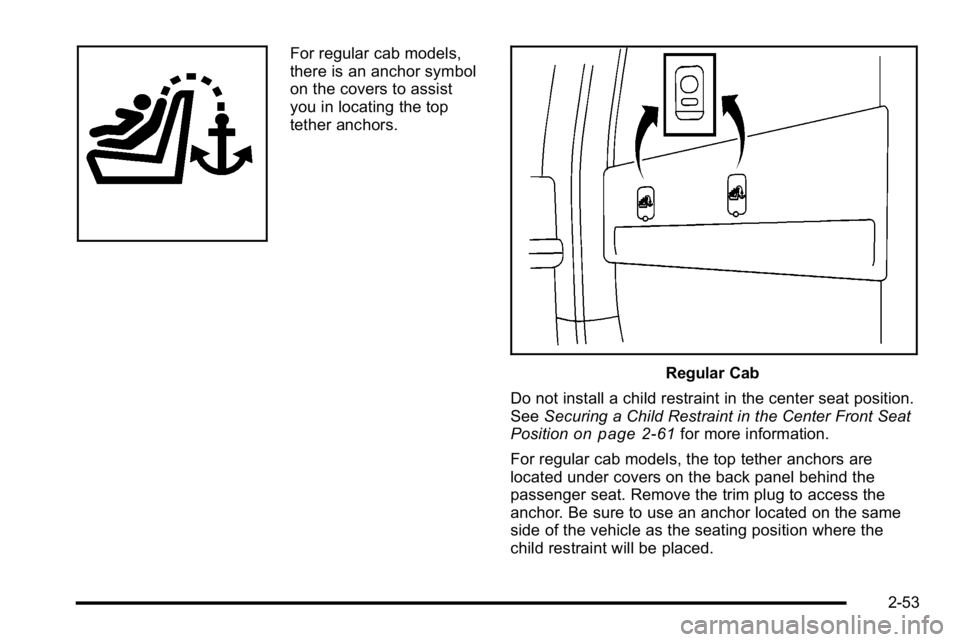
For regular cab models,
there is an anchor symbol
on the covers to assist
you in locating the top
tether anchors.
Regular Cab
Do not install a child restraint in the center seat position.
See Securing a Child Restraint in the Center Front Seat
Position
on page 2‑61for more information.
For regular cab models, the top tether anchors are
located under covers on the back panel behind the
passenger seat. Remove the trim plug to access the
anchor. Be sure to use an anchor located on the same
side of the vehicle as the seating position where the
child restraint will be placed.
2-53
Page 96 of 630
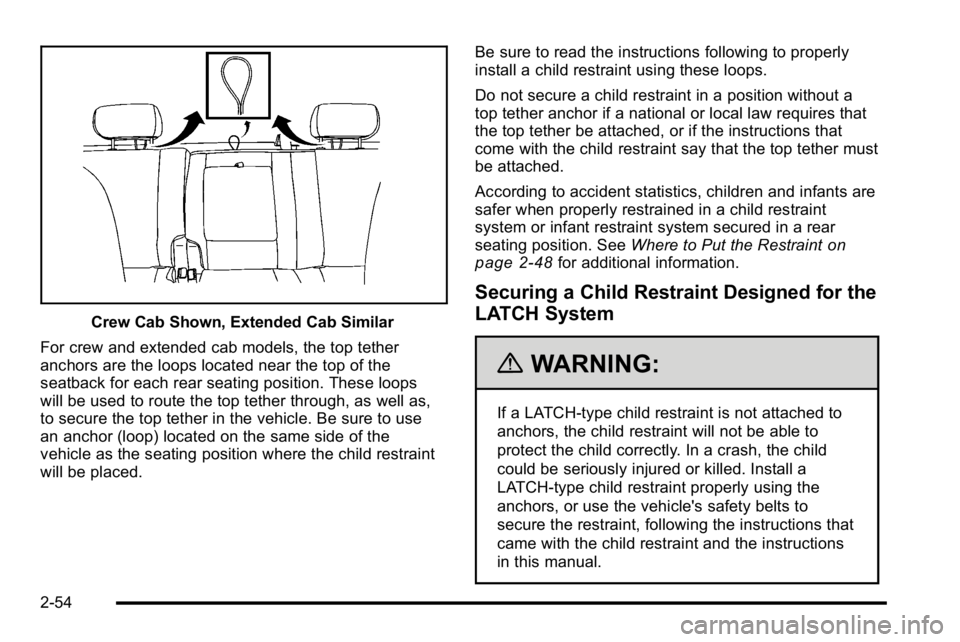
Crew Cab Shown, Extended Cab Similar
For crew and extended cab models, the top tether
anchors are the loops located near the top of the
seatback for each rear seating position. These loops
will be used to route the top tether through, as well as,
to secure the top tether in the vehicle. Be sure to use
an anchor (loop) located on the same side of the
vehicle as the seating position where the child restraint
will be placed. Be sure to read the instructions following to properly
install a child restraint using these loops.
Do not secure a child restraint in a position without a
top tether anchor if a national or local law requires that
the top tether be attached, or if the instructions that
come with the child restraint say that the top tether must
be attached.
According to accident statistics, children and infants are
safer when properly restrained in a child restraint
system or infant restraint system secured in a rear
seating position. See
Where to Put the Restraint
on
page 2‑48for additional information.
Securing a Child Restraint Designed for the
LATCH System
{WARNING:
If a LATCH-type child restraint is not attached to
anchors, the child restraint will not be able to
protect the child correctly. In a crash, the child
could be seriously injured or killed. Install a
LATCH-type child restraint properly using the
anchors, or use the vehicle's safety belts to
secure the restraint, following the instructions that
came with the child restraint and the instructions
in this manual.
2-54
Page 98 of 630

1. 3. Remove the cover to expose the anchor.
1. 4. Route, attach, and tighten the top tetheraccording to your child restraint instructions
and the following instructions:
If the position you are
using has an adjustable
headrest or head restraint
and you are using a dual
tether, route the tether
around the headrest or
head restraint .
If the position you are
using has an adjustable
headrest or head restraint
and you are using a
single tether, raise the
headrest or head restraint
and route the tether under
the headrest or head
restraint and in between
the headrest or head
restraint posts. 2. See
Securing a Child Restraint in the Right Front
Seat Position (With Passenger Sensing System)
on page 2‑62or Securing a Child Restraint in the
Right Front Seat Position (With Airbag Off Switch)
on page 2‑66or Securing a Child Restraint in the
Right Front Seat Position (Heavy Duty Crew Cab
Only)
on page 2‑70for instructions on installing
the child restraint using the safety belts.
3. Push and pull the child restraint in different directions to be sure it is secure.
Crew and Extended Cab Models
1. Attach and tighten the lower attachments to thelower anchors. If the child restraint does not have
lower attachments or the desired seating position
does not have lower anchors, secure the child
restraint with the top tether and the safety belts.
Refer to your child restraint manufacturer
instructions and the instructions in this manual.
1. 1. Find the lower anchors for the desired seating position.
1. 2. Put the child restraint on the seat.
1. 3. Attach and tighten the lower attachments on the child restraint to the lower anchors.
2-56
Page 100 of 630

2. 2. When using a child restraint with a top tetherin the rear center position:
A. Route the top tether (B) through the
center loop (D), and behind the inboard
passenger side headrest or head
restraint post.
B. Attach the top tether (B) to the top tether anchor (loop) at the rear passenger side
seating position.
2. 3. When using a child restraint with a top tether in the rear passenger position:
A. Raise the headrest or head restraint .
B. Route the top tether (B) between theheadrest or head restraint posts, through
the loop on the passenger side and
behind the inboard headrest or head
restraint post.
C. Attach the top tether (B) to the top tether anchor (loop) (D) at the center rear
seating position.
2. 4. Tighten the top tether when and as the child restraint manufacturer's instructions say.
When the top tether is tightened, the anchor
(loop) may bend. This is normal and will not
damage the vehicle.
3. Push and pull the child restraint in different directions to be sure it is secure.Securing a Child Restraint in a Rear
Seat Position
When securing a child restraint in a rear seating
position, study the instructions that came with the child
restraint to make sure it is compatible with this vehicle.
If the child restraint has the LATCH system, see Lower
Anchors and Tethers for Children (LATCH)
on
page 2‑50for how and where to install the child
restraint using LATCH. If a child restraint is secured in
the vehicle using a safety belt and it uses a top tether,
see Lower Anchors and Tethers for Children (LATCH)
on page 2‑50for top tether anchor locations.
Do not secure a child seat in a position without a top
tether anchor if a national or local law requires that the
top tether be anchored, or if the instructions that come
with the child restraint say that the top strap must be
anchored.
In Canada, the law requires that forward-facing child
restraints have a top tether, and that the tether be
attached.
If the child restraint does not have the LATCH system,
you will be using the safety belt to secure the child
restraint in this position. Be sure to follow the
instructions that came with the child restraint. Secure
the child in the child restraint when and as the
instructions say.
2-58
Page 103 of 630
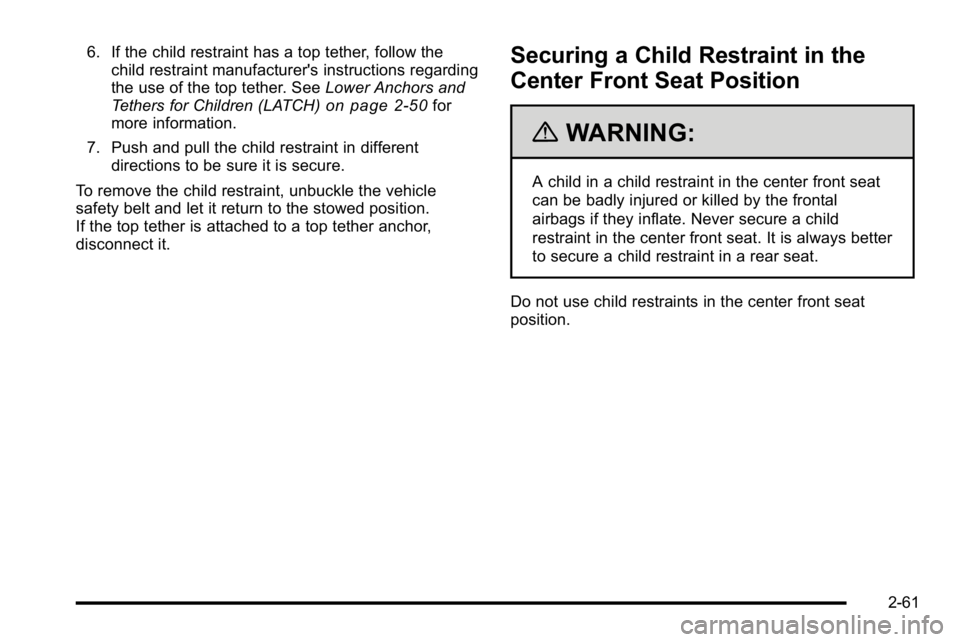
6. If the child restraint has a top tether, follow thechild restraint manufacturer's instructions regarding
the use of the top tether. See Lower Anchors and
Tethers for Children (LATCH)
on page 2‑50for
more information.
7. Push and pull the child restraint in different directions to be sure it is secure.
To remove the child restraint, unbuckle the vehicle
safety belt and let it return to the stowed position.
If the top tether is attached to a top tether anchor,
disconnect it.
Securing a Child Restraint in the
Center Front Seat Position
{WARNING:
A child in a child restraint in the center front seat
can be badly injured or killed by the frontal
airbags if they inflate. Never secure a child
restraint in the center front seat. It is always better
to secure a child restraint in a rear seat.
Do not use child restraints in the center front seat
position.
2-61
Page 104 of 630
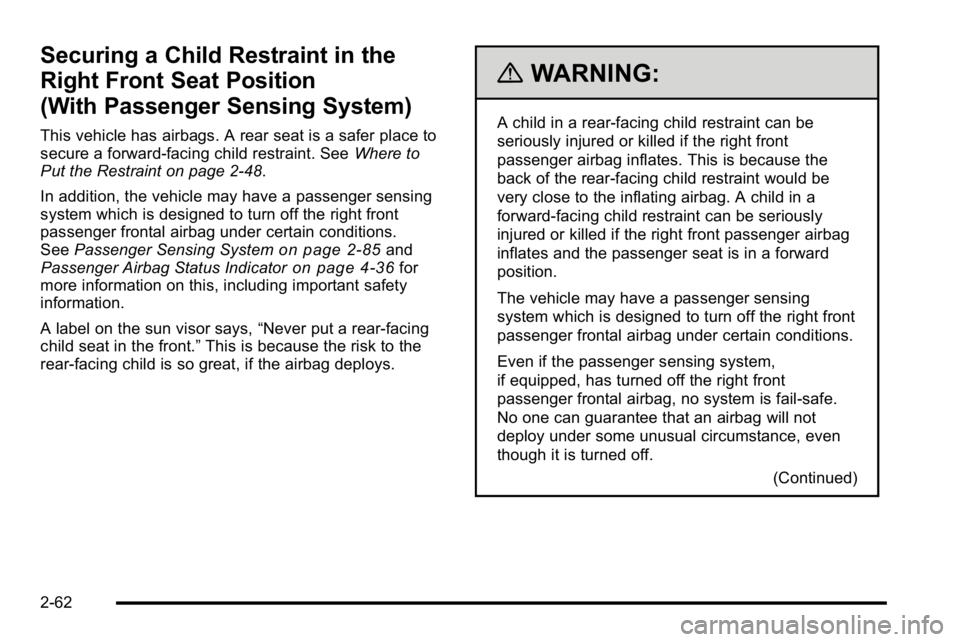
Securing a Child Restraint in the
Right Front Seat Position
(With Passenger Sensing System)
This vehicle has airbags. A rear seat is a safer place to
secure a forward-facing child restraint. SeeWhere to
Put the Restraint on page 2‑48.
In addition, the vehicle may have a passenger sensing
system which is designed to turn off the right front
passenger frontal airbag under certain conditions.
See Passenger Sensing System
on page 2‑85and
Passenger Airbag Status Indicatoron page 4‑36for
more information on this, including important safety
information.
A label on the sun visor says, “Never put a rear-facing
child seat in the front.” This is because the risk to the
rear-facing child is so great, if the airbag deploys.
{WARNING:
A child in a rear-facing child restraint can be
seriously injured or killed if the right front
passenger airbag inflates. This is because the
back of the rear-facing child restraint would be
very close to the inflating airbag. A child in a
forward-facing child restraint can be seriously
injured or killed if the right front passenger airbag
inflates and the passenger seat is in a forward
position.
The vehicle may have a passenger sensing
system which is designed to turn off the right front
passenger frontal airbag under certain conditions.
Even if the passenger sensing system,
if equipped, has turned off the right front
passenger frontal airbag, no system is fail-safe.
No one can guarantee that an airbag will not
deploy under some unusual circumstance, even
though it is turned off.
(Continued)
2-62
Page 105 of 630
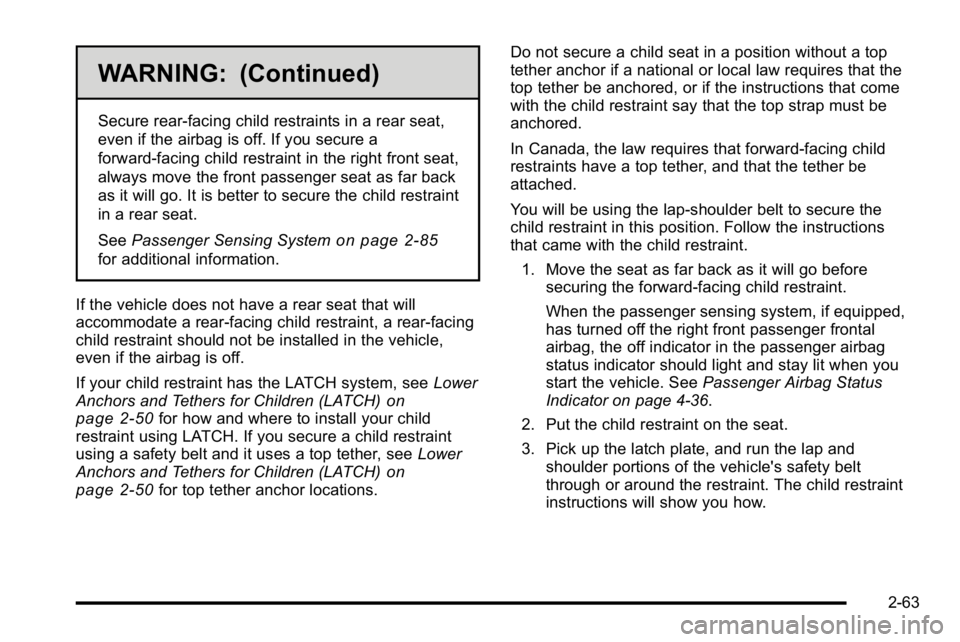
WARNING: (Continued)
Secure rear-facing child restraints in a rear seat,
even if the airbag is off. If you secure a
forward-facing child restraint in the right front seat,
always move the front passenger seat as far back
as it will go. It is better to secure the child restraint
in a rear seat.
SeePassenger Sensing System
on page 2‑85
for additional information.
If the vehicle does not have a rear seat that will
accommodate a rear-facing child restraint, a rear-facing
child restraint should not be installed in the vehicle,
even if the airbag is off.
If your child restraint has the LATCH system, see Lower
Anchors and Tethers for Children (LATCH)
on
page 2‑50for how and where to install your child
restraint using LATCH. If you secure a child restraint
using a safety belt and it uses a top tether, see Lower
Anchors and Tethers for Children (LATCH)
on
page 2‑50for top tether anchor locations. Do not secure a child seat in a position without a top
tether anchor if a national or local law requires that the
top tether be anchored, or if the instructions that come
with the child restraint say that the top strap must be
anchored.
In Canada, the law requires that forward-facing child
restraints have a top tether, and that the tether be
attached.
You will be using the lap-shoulder belt to secure the
child restraint in this position. Follow the instructions
that came with the child restraint.
1. Move the seat as far back as it will go before securing the forward-facing child restraint.
When the passenger sensing system, if equipped,
has turned off the right front passenger frontal
airbag, the off indicator in the passenger airbag
status indicator should light and stay lit when you
start the vehicle. See Passenger Airbag Status
Indicator on page 4‑36.
2. Put the child restraint on the seat.
3. Pick up the latch plate, and run the lap and shoulder portions of the vehicle's safety belt
through or around the restraint. The child restraint
instructions will show you how.
2-63
Page 107 of 630
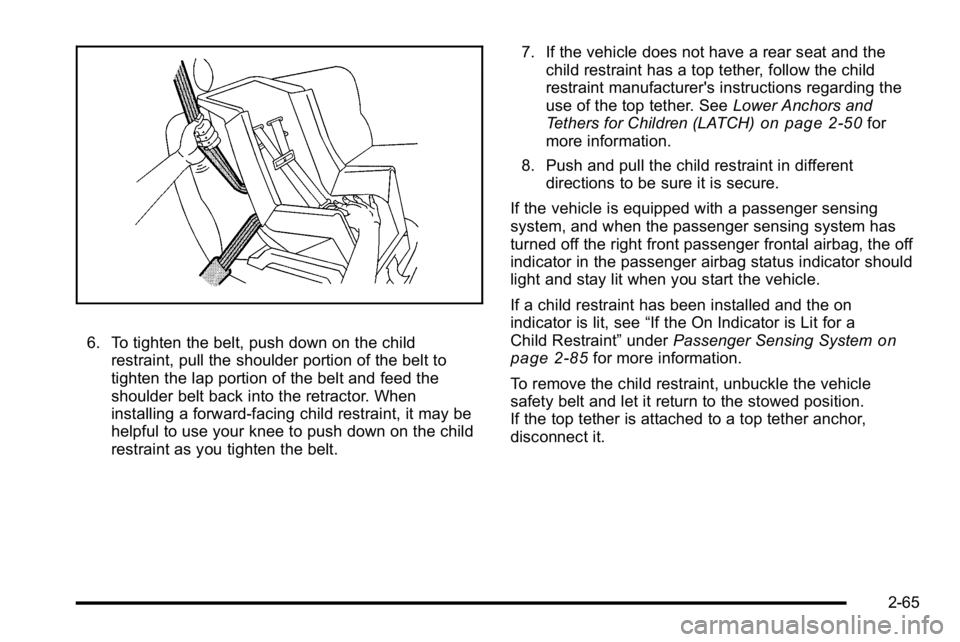
6. To tighten the belt, push down on the childrestraint, pull the shoulder portion of the belt to
tighten the lap portion of the belt and feed the
shoulder belt back into the retractor. When
installing a forward-facing child restraint, it may be
helpful to use your knee to push down on the child
restraint as you tighten the belt. 7. If the vehicle does not have a rear seat and the
child restraint has a top tether, follow the child
restraint manufacturer's instructions regarding the
use of the top tether. See Lower Anchors and
Tethers for Children (LATCH)
on page 2‑50for
more information.
8. Push and pull the child restraint in different directions to be sure it is secure.
If the vehicle is equipped with a passenger sensing
system, and when the passenger sensing system has
turned off the right front passenger frontal airbag, the off
indicator in the passenger airbag status indicator should
light and stay lit when you start the vehicle.
If a child restraint has been installed and the on
indicator is lit, see “If the On Indicator is Lit for a
Child Restraint” underPassenger Sensing System
on
page 2‑85for more information.
To remove the child restraint, unbuckle the vehicle
safety belt and let it return to the stowed position.
If the top tether is attached to a top tether anchor,
disconnect it.
2-65